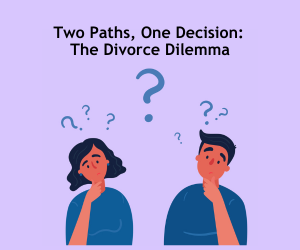 I am often asked what a “drafting” process for divorce entails. While a full process often has 3-5 professionals, a process for clients who have worked out most of the resolutions on their own, can be much more streamlined. Using an attorney for legal advice and drafting can be a cost-effective and quick way to proceed. Here is how the process typically works:
1. Client hires attorney. In a drafting process, the client should hire an attorney who is willing to take on a drafting role – drafting the agreement and advising the client of his/her legal rights.
2. Client and attorney meet to discuss the resolutions reached. In a drafting process, the clients have typically already reached agreement on property division and cash flow. They have disclosed everything to each other and made decisions about how to divide the property (assets and liabilities) and agreed upon child support and/or spousal maintenance if needed. In this initial meeting, the client provides the attorney all supporting documentation and discusses the agreements reached. The attorney advises the client of the legal implications of the agreements and either confirms the agreements or discusses potential revisions. Sometimes, the attorney brings up ideas or questions that the client has not yet contemplated. If so, the client can go back to their spouse and discuss these additional matters.
3. Once the final agreements are discussed, attorney can draft the documents. In Minnesota, the substantive divorce document is a Stipulated Judgment and Decree. There are other supporting documents needed, but this is the main document needed. This Judgment and Decree outlines all resolutions that have been agreed upon.
4. Client reviews the documentation.
5. Spouse reviews the documentation and has an attorney review and advise him/her of the legal implications.
6. The attorneys and clients can communicate and revise the documentation as needed.
7. Once finalized, the documents are signed by clients and attorneys and filed.
While a drafting process can be efficient and cost-effective, it works best when clients have all agreements in place and do not waiver from their original positions. If the clients learn more about their legal rights and wants to further explore options, it is often best to enter into a collaborative process, where more options can be explored.
I am often asked what a “drafting” process for divorce entails. While a full process often has 3-5 professionals, a process for clients who have worked out most of the resolutions on their own, can be much more streamlined. Using an attorney for legal advice and drafting can be a cost-effective and quick way to proceed. Here is how the process typically works:
1. Client hires attorney. In a drafting process, the client should hire an attorney who is willing to take on a drafting role – drafting the agreement and advising the client of his/her legal rights.
2. Client and attorney meet to discuss the resolutions reached. In a drafting process, the clients have typically already reached agreement on property division and cash flow. They have disclosed everything to each other and made decisions about how to divide the property (assets and liabilities) and agreed upon child support and/or spousal maintenance if needed. In this initial meeting, the client provides the attorney all supporting documentation and discusses the agreements reached. The attorney advises the client of the legal implications of the agreements and either confirms the agreements or discusses potential revisions. Sometimes, the attorney brings up ideas or questions that the client has not yet contemplated. If so, the client can go back to their spouse and discuss these additional matters.
3. Once the final agreements are discussed, attorney can draft the documents. In Minnesota, the substantive divorce document is a Stipulated Judgment and Decree. There are other supporting documents needed, but this is the main document needed. This Judgment and Decree outlines all resolutions that have been agreed upon.
4. Client reviews the documentation.
5. Spouse reviews the documentation and has an attorney review and advise him/her of the legal implications.
6. The attorneys and clients can communicate and revise the documentation as needed.
7. Once finalized, the documents are signed by clients and attorneys and filed.
While a drafting process can be efficient and cost-effective, it works best when clients have all agreements in place and do not waiver from their original positions. If the clients learn more about their legal rights and wants to further explore options, it is often best to enter into a collaborative process, where more options can be explored.
Two Paths, One Decision: The Divorce Dilemma
Emily and Daniel were in love. Their love story had once been the envy of the neighborhood—a whirlwind romance that blossomed into a marriage filled with laughter, shared dreams, and whispered secrets. But as the years went by, cracks appeared in their fairy tale....



